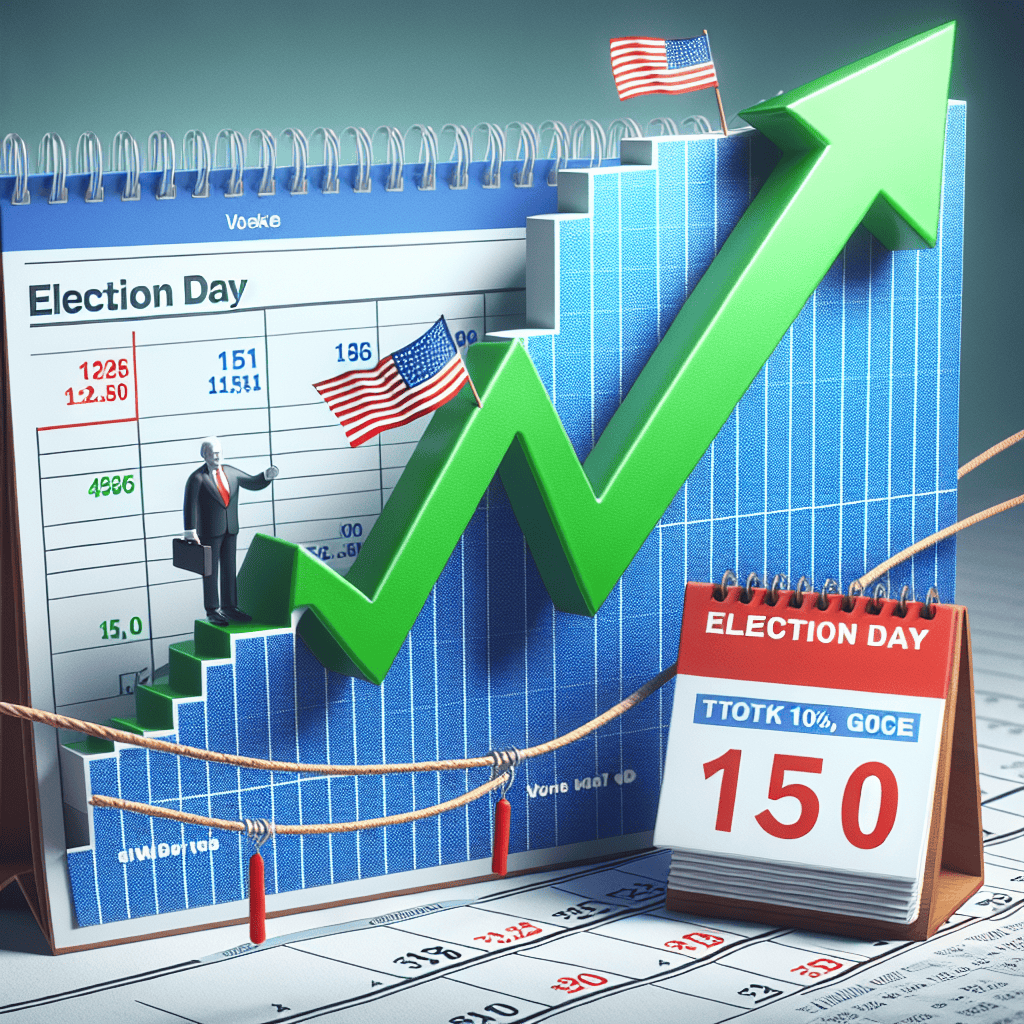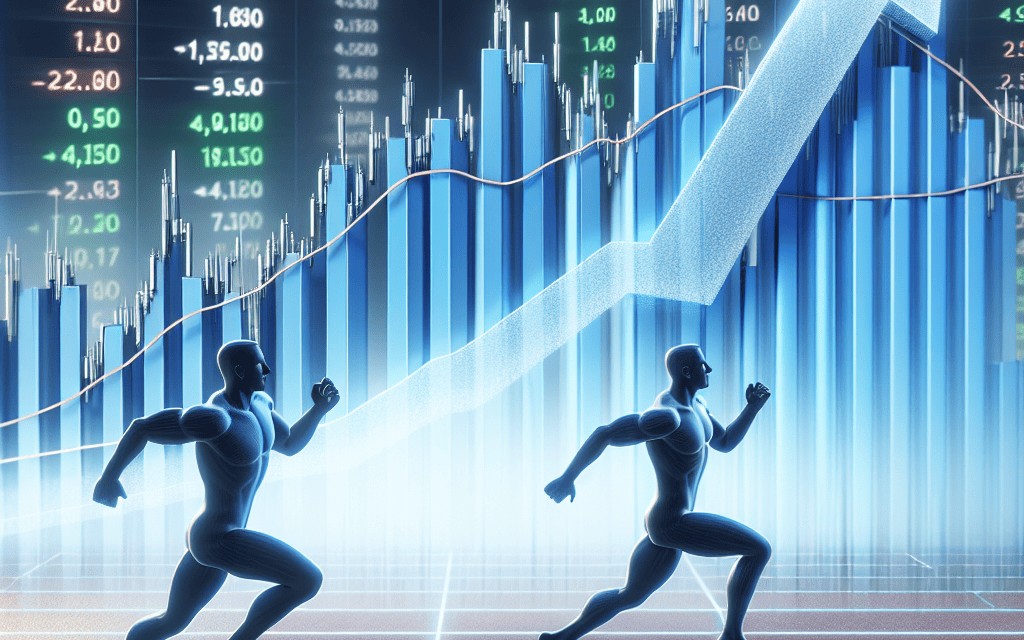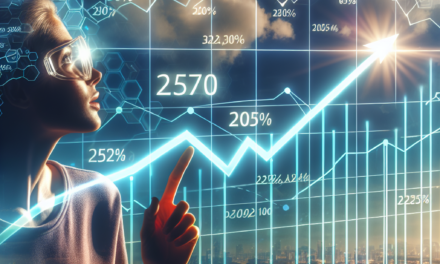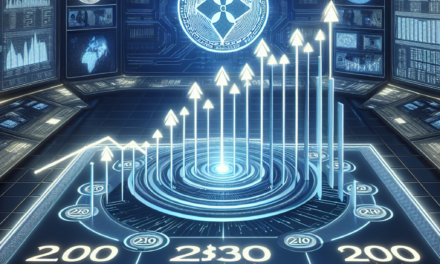“Markets Surge as Voters Decide: Dow Climbs 150 Points in Trump-Harris Election Showdown”
Introduction
On Election Day, the stock market showed signs of optimism as the Dow Jones Industrial Average climbed 150 points, reflecting investor sentiment amid a closely contested presidential race between Donald Trump and Kamala Harris. The financial markets, often sensitive to political developments, responded to the unfolding electoral dynamics, with traders and investors closely monitoring the potential implications of the election outcome on economic policies and market stability. The rise in the Dow highlighted a cautious yet hopeful outlook as the nation awaited the results of a pivotal election that could shape the economic landscape for years to come.
Market Reactions: How Elections Influence Stock Market Movements
On Election Day, the stock market often becomes a barometer of investor sentiment, reflecting the uncertainty and anticipation surrounding the political landscape. This year, as the nation watches a tightly contested race between former President Donald Trump and Vice President Kamala Harris, the Dow Jones Industrial Average has risen by 150 points. This uptick in the market underscores the complex interplay between political events and economic expectations, as investors attempt to navigate the potential implications of the election outcome on fiscal policies, regulatory environments, and overall economic stability.
Historically, elections have had a significant impact on market movements, with investors closely monitoring the potential shifts in policy that could arise from a change in administration. The current election is no exception, as the contrasting platforms of Trump and Harris present distinct economic pathways. Trump’s policies have traditionally focused on tax cuts, deregulation, and a pro-business agenda, which have generally been well-received by the market. Conversely, Harris’s platform emphasizes increased government spending on social programs, climate initiatives, and healthcare, which could lead to higher taxes and more stringent regulations. These divergent approaches create a sense of uncertainty, prompting investors to adjust their portfolios in anticipation of the possible outcomes.
Moreover, the market’s reaction is not solely based on the candidates’ economic policies but also on the broader implications of their leadership styles and geopolitical strategies. Trump’s tenure was marked by a focus on America-first policies, trade tensions, and an unpredictable approach to international relations. In contrast, Harris is perceived as likely to adopt a more collaborative and multilateral approach, potentially easing trade tensions and fostering international cooperation. These differences in leadership style can influence investor confidence and market stability, as global economic interdependence plays a crucial role in shaping domestic market conditions.
In addition to the immediate reactions to the election results, investors are also considering the long-term economic outlook. The ongoing challenges posed by inflation, supply chain disruptions, and the lingering effects of the COVID-19 pandemic add layers of complexity to the market’s response. As such, the election serves as a pivotal moment for investors to reassess their strategies, balancing short-term volatility with long-term growth prospects. The rise in the Dow Jones Industrial Average by 150 points on Election Day may reflect a cautious optimism among investors, who are hopeful for a resolution that will provide clarity and direction for the future.
Furthermore, it is important to recognize that the stock market is not a monolithic entity; different sectors may react differently to the election outcome. For instance, technology and healthcare stocks might respond more favorably to Harris’s policies, given her focus on innovation and healthcare reform. On the other hand, energy and financial sectors might benefit from Trump’s deregulatory stance. This sectoral divergence highlights the nuanced nature of market reactions, as investors weigh the potential benefits and drawbacks of each candidate’s platform.
In conclusion, the 150-point rise in the Dow Jones Industrial Average on Election Day amid the tight Trump-Harris race exemplifies the intricate relationship between political events and market dynamics. As investors navigate this period of uncertainty, they must consider not only the immediate implications of the election outcome but also the broader economic landscape and sector-specific impacts. Through careful analysis and strategic decision-making, investors can position themselves to capitalize on opportunities while mitigating risks in an ever-evolving market environment.
Historical Analysis: Stock Market Trends During Presidential Elections
The stock market has long been a barometer of economic sentiment, often reflecting the nation’s mood during pivotal moments such as presidential elections. Historically, the market’s performance during election years can offer insights into investor confidence and expectations about future economic policies. On Election Day, the Dow Jones Industrial Average rose by 150 points, a movement that underscores the market’s reaction to the tight race between former President Donald Trump and Vice President Kamala Harris. This increase, while seemingly modest, is part of a broader historical pattern where markets exhibit volatility and responsiveness to political developments.
To understand the significance of this rise, it is essential to consider the historical context of stock market behavior during presidential elections. Traditionally, markets tend to experience increased volatility in the months leading up to an election. This is largely due to the uncertainty surrounding potential policy changes that could impact various sectors of the economy. Investors often adjust their portfolios in anticipation of shifts in fiscal policy, regulatory changes, and international trade agreements that are typically influenced by the incoming administration’s agenda.
Moreover, the stock market’s performance on Election Day itself can be indicative of investor sentiment regarding the candidates’ economic platforms. In the case of the Trump-Harris race, the market’s positive movement suggests a degree of optimism or relief among investors. This could be attributed to several factors, including the candidates’ stances on taxation, government spending, and regulatory policies. Historically, markets have responded favorably to candidates perceived as pro-business, as their policies are often seen as conducive to economic growth and corporate profitability.
Furthermore, it is important to note that the stock market’s reaction on Election Day is not always a reliable predictor of long-term trends. While a rise in the Dow may reflect immediate investor sentiment, the market’s trajectory in the weeks and months following the election is often influenced by the actual implementation of policies and the broader economic environment. For instance, past elections have shown that initial market reactions can be reversed as the realities of governance and legislative processes unfold.
In addition to the immediate impact of election results, historical analysis reveals that the stock market’s performance during election years is also shaped by external factors such as global economic conditions, interest rates, and geopolitical events. These elements can either amplify or mitigate the market’s response to political developments, adding another layer of complexity to the analysis of election-related market trends.
In conclusion, the 150-point rise in the Dow on Election Day amid the tight Trump-Harris race is a reflection of the market’s sensitivity to political dynamics and investor expectations. While this movement aligns with historical patterns of market behavior during presidential elections, it is crucial to consider the broader context and potential long-term implications. As investors navigate the uncertainties of the political landscape, they must remain vigilant and adaptable, recognizing that the stock market is influenced by a myriad of factors beyond the immediate outcome of an election. This nuanced understanding of historical trends can provide valuable insights for investors seeking to make informed decisions in an ever-evolving economic environment.
Investor Sentiment: Understanding Market Behavior in Political Uncertainty
On Election Day, the Dow Jones Industrial Average experienced a notable rise of 150 points, reflecting the complex interplay between investor sentiment and political uncertainty. As the nation focused on the tight race between former President Donald Trump and Vice President Kamala Harris, market participants were keenly aware of the potential implications of the election outcome on economic policies and, consequently, on their investment portfolios. This upward movement in the Dow can be attributed to a variety of factors, including investor expectations, historical market behavior during election periods, and the broader economic context.
To begin with, investor sentiment plays a crucial role in shaping market behavior, particularly during periods of political uncertainty. Investors often react to the perceived stability or instability that a particular candidate might bring to the economic landscape. In this case, the close contest between Trump and Harris has led to heightened anticipation regarding future fiscal policies, trade agreements, and regulatory changes. Investors, therefore, tend to adjust their portfolios in anticipation of these potential shifts, leading to fluctuations in market indices such as the Dow.
Moreover, historical patterns suggest that markets often experience increased volatility during election cycles. This is primarily due to the uncertainty surrounding potential policy changes that could impact various sectors differently. For instance, a Trump victory might be perceived as favorable for industries such as energy and finance due to his administration’s previous deregulatory stance. Conversely, a Harris win could signal increased support for renewable energy and healthcare sectors, given her party’s policy priorities. As investors weigh these possibilities, their collective actions contribute to the market’s overall movement.
In addition to investor sentiment and historical trends, the broader economic context cannot be overlooked. The U.S. economy has been navigating a complex landscape marked by inflationary pressures, supply chain disruptions, and a post-pandemic recovery. These factors add another layer of complexity to investor decision-making processes. On Election Day, the rise in the Dow may also reflect a degree of optimism about the economy’s resilience and the potential for continued growth, regardless of the election outcome. Investors might be betting on the strength of corporate earnings and the adaptability of businesses to navigate the evolving economic environment.
Furthermore, it is essential to consider the role of global markets and geopolitical factors in shaping investor sentiment. The interconnectedness of global economies means that U.S. elections can have far-reaching implications beyond domestic borders. International investors closely monitor U.S. political developments, as changes in leadership can influence global trade dynamics, foreign policy, and international relations. Consequently, the Dow’s performance on Election Day may also be influenced by the reactions of global markets to the unfolding political scenario.
In conclusion, the 150-point rise in the Dow on Election Day amid the tight Trump-Harris race underscores the intricate relationship between investor sentiment and political uncertainty. As investors navigate the complexities of potential policy changes, historical market behavior, and the broader economic context, their collective actions drive market movements. Understanding these dynamics is crucial for investors seeking to make informed decisions in an ever-evolving political and economic landscape. As the election results unfold, market participants will continue to assess the implications for their investment strategies, highlighting the ongoing interplay between politics and market behavior.
Economic Indicators: What a 150-Point Rise Means for the Dow

On Election Day, the Dow Jones Industrial Average experienced a notable rise of 150 points, reflecting the market’s response to the tight presidential race between Donald Trump and Kamala Harris. This increase in the Dow is a significant indicator of investor sentiment and economic expectations, as the stock market often reacts to political events that could influence future economic policies. The 150-point rise suggests a degree of optimism among investors, who may be anticipating favorable outcomes from the election that could bolster economic growth and stability.
The Dow Jones Industrial Average, a key barometer of the U.S. stock market, comprises 30 major publicly traded companies. A rise of 150 points, while not unprecedented, is a meaningful movement that can signal investor confidence. This uptick may be attributed to several factors, including expectations of policy continuity or change, potential fiscal stimulus, and the overall economic outlook. As investors weigh the implications of a Trump or Harris presidency, their trading decisions reflect their predictions about which candidate’s policies might better support economic expansion.
Moreover, the stock market’s performance on Election Day can also be influenced by broader economic indicators and global market trends. For instance, recent economic data, such as employment figures, consumer spending, and corporate earnings, can shape investor expectations and contribute to market movements. Additionally, international factors, such as trade relations and geopolitical tensions, may also play a role in shaping market sentiment. In this context, the 150-point rise in the Dow could be seen as a response not only to the election itself but also to a confluence of economic signals that investors are interpreting as positive.
Furthermore, the tight race between Trump and Harris adds an element of uncertainty to the market, which can lead to increased volatility. Investors often react to uncertainty by adjusting their portfolios to mitigate potential risks. However, the rise in the Dow suggests that, despite the close contest, there is a prevailing sense of confidence that the election outcome will ultimately support economic resilience. This confidence may stem from the belief that either candidate will implement policies aimed at sustaining economic recovery in the wake of recent challenges.
In addition to domestic considerations, the global economic environment also plays a crucial role in influencing the Dow’s performance. As the world continues to navigate the complexities of post-pandemic recovery, investors are closely monitoring international developments that could impact the U.S. economy. Trade agreements, supply chain disruptions, and foreign policy decisions are all factors that can affect market dynamics. The 150-point rise in the Dow on Election Day may reflect a broader optimism about the global economic landscape and the potential for collaborative efforts to address shared challenges.
In conclusion, the 150-point rise in the Dow Jones Industrial Average on Election Day amid the tight Trump-Harris race is a multifaceted indicator of investor sentiment. It reflects optimism about the potential economic policies of the next administration, as well as broader economic and global factors. As investors continue to navigate the uncertainties of the political landscape, the stock market will remain a critical gauge of economic expectations and confidence. This rise underscores the complex interplay between politics, economics, and market dynamics, highlighting the importance of closely monitoring these indicators to understand their implications for the future.
Election Day Trading: Strategies for Navigating Volatile Markets
On Election Day, the financial markets often experience heightened volatility as investors react to the unfolding political landscape. This year, the Dow Jones Industrial Average rose by 150 points, reflecting the market’s response to the tight race between former President Donald Trump and Vice President Kamala Harris. As investors navigate these turbulent waters, understanding effective trading strategies becomes crucial for managing risk and capitalizing on potential opportunities.
Firstly, it is essential to recognize that election outcomes can significantly impact market sentiment and economic policies. Investors often anticipate changes in fiscal policy, regulatory environments, and international trade agreements, all of which can influence market dynamics. Consequently, traders must remain vigilant and informed about the latest developments, as these can lead to rapid shifts in market conditions. By staying updated, investors can make more informed decisions and adjust their strategies accordingly.
Moreover, diversification remains a fundamental strategy for mitigating risk during volatile periods. By spreading investments across various asset classes, sectors, and geographic regions, traders can reduce their exposure to any single market event or political outcome. This approach not only helps in cushioning against potential losses but also provides opportunities to benefit from different market trends. For instance, while certain sectors may experience downturns due to anticipated policy changes, others might thrive, offering a balanced portfolio the potential for overall gains.
In addition to diversification, employing hedging techniques can further protect investments. Options and futures contracts are popular tools that allow traders to hedge against adverse price movements. By locking in prices or purchasing the right to sell assets at a predetermined price, investors can safeguard their portfolios from unexpected market swings. This strategy is particularly useful during election periods when uncertainty is at its peak, and market reactions can be unpredictable.
Furthermore, maintaining a long-term perspective is vital when trading in volatile markets. While short-term fluctuations can be unsettling, it is important to remember that markets tend to stabilize over time. By focusing on long-term investment goals and avoiding impulsive decisions based on daily market movements, traders can better withstand the temporary turbulence associated with election cycles. Patience and discipline are key virtues that can help investors navigate through periods of uncertainty without succumbing to panic.
Additionally, employing technical analysis can provide valuable insights into market trends and potential entry or exit points. By analyzing historical price patterns, volume data, and other technical indicators, traders can identify potential opportunities and make more informed decisions. This analytical approach complements fundamental analysis, which focuses on economic indicators and company performance, providing a comprehensive view of the market landscape.
Finally, it is crucial for investors to remain adaptable and open to adjusting their strategies as new information becomes available. The political landscape is inherently dynamic, and market conditions can change rapidly in response to election outcomes and subsequent policy announcements. By staying flexible and ready to pivot their strategies, traders can better position themselves to capitalize on emerging opportunities and mitigate potential risks.
In conclusion, navigating volatile markets on Election Day requires a combination of informed decision-making, strategic diversification, effective hedging, and a long-term perspective. By employing these strategies, investors can better manage the uncertainties associated with political events and position themselves for success in the ever-evolving financial landscape. As the tight Trump-Harris race unfolds, the Dow’s rise of 150 points serves as a reminder of the market’s sensitivity to political developments and the importance of strategic trading during such pivotal moments.
Political Impact: How the Trump-Harris Race Affects Financial Markets
On Election Day, the financial markets exhibited a notable response as the Dow Jones Industrial Average rose by 150 points, reflecting investor sentiment amid the closely contested race between former President Donald Trump and Vice President Kamala Harris. This election cycle has been marked by heightened political tensions and economic uncertainties, prompting investors to closely monitor the potential implications of the election outcome on financial markets. The rise in the Dow can be attributed to a combination of factors, including investor optimism about potential policy directions and the anticipated impact on various sectors of the economy.
The Trump-Harris race has captivated the nation, with both candidates presenting starkly different visions for the future of the United States. As investors weigh the potential outcomes, they are particularly focused on how each candidate’s policies might influence economic growth, regulatory environments, and fiscal strategies. Trump’s platform, characterized by a focus on deregulation and tax cuts, has historically been viewed favorably by the business community. In contrast, Harris’s approach emphasizes social equity, climate change initiatives, and increased government spending, which could lead to shifts in market dynamics.
In this context, the financial markets are responding to the perceived stability and predictability that each candidate might bring. The 150-point rise in the Dow suggests a degree of confidence among investors, possibly reflecting an expectation that the election results will lead to a clear and decisive outcome, thereby reducing uncertainty. Moreover, the markets are likely factoring in the potential for a balanced government, which could mitigate extreme policy shifts and foster a more stable economic environment.
Transitioning to the broader economic implications, it is essential to consider how the election results might affect key sectors. For instance, a Trump victory could bolster industries such as energy and finance, given his administration’s track record of rolling back regulations in these areas. Conversely, a Harris win might benefit sectors like renewable energy and healthcare, aligning with her policy priorities. Investors are keenly aware of these sectoral impacts, and their trading decisions reflect an anticipation of how different industries might fare under each candidate’s leadership.
Furthermore, the international dimension of the election cannot be overlooked. Global markets are closely watching the U.S. election, as the outcome will inevitably influence international trade relations and geopolitical dynamics. A Trump administration might continue its focus on America-first policies, potentially leading to trade tensions with key partners. On the other hand, a Harris administration could signal a shift towards multilateralism and renewed engagement with global institutions, which might be perceived as stabilizing by international investors.
In conclusion, the 150-point rise in the Dow on Election Day underscores the intricate relationship between political developments and financial markets. As the Trump-Harris race unfolds, investors are navigating a complex landscape of potential policy changes and economic implications. The financial markets serve as a barometer of investor sentiment, reflecting both optimism and caution as the nation awaits the election results. Ultimately, the outcome of this closely watched race will have far-reaching consequences, shaping the economic trajectory of the United States and influencing global financial markets in the years to come.
Future Projections: Anticipating Market Trends Post-Election Results
As the Dow Jones Industrial Average climbed 150 points on Election Day, investors and analysts alike turned their attention to the potential market trends that could emerge following the results of the tightly contested Trump-Harris race. This election, marked by its unique political dynamics and economic implications, has left market participants speculating about the future trajectory of the financial markets. The immediate uptick in the Dow suggests a cautious optimism among investors, yet the underlying factors driving this sentiment warrant a closer examination.
To begin with, the stock market often reacts to the perceived stability or volatility associated with political outcomes. In this particular election, the contrasting economic policies of the candidates have been a focal point for investors. President Trump’s administration has been characterized by tax cuts, deregulation, and a focus on bolstering domestic industries, which have generally been well-received by the market. Conversely, Vice President Harris, running on a platform that emphasizes social equity and environmental sustainability, proposes policies that could lead to increased regulation and changes in corporate taxation. As such, the market’s response to the election results will likely hinge on the anticipated impact of these policies on corporate profitability and economic growth.
Moreover, the broader economic context cannot be ignored. The global economy is still grappling with the aftereffects of the COVID-19 pandemic, supply chain disruptions, and inflationary pressures. These factors add layers of complexity to the market’s response to the election outcome. A Trump victory might be perceived as a continuation of the status quo, potentially providing a sense of continuity for businesses and investors. On the other hand, a Harris win could signal a shift towards policies aimed at addressing long-term structural issues, which might initially unsettle markets but could foster sustainable growth in the long run.
In addition to domestic policies, international relations play a crucial role in shaping market expectations. The Trump administration’s approach to trade, particularly with China, has been a source of volatility in recent years. A second term could mean further trade tensions, which might weigh on global markets. Conversely, a Harris administration might pursue a more diplomatic approach, potentially easing trade relations and fostering a more stable international economic environment. This aspect of foreign policy will be closely monitored by investors as they assess the potential impact on global supply chains and international trade agreements.
Furthermore, the role of fiscal and monetary policy in the post-election landscape cannot be overstated. The Federal Reserve’s stance on interest rates and quantitative easing will be pivotal in shaping market dynamics. A Trump administration might continue to advocate for low interest rates to stimulate economic growth, while a Harris administration could prioritize fiscal measures aimed at reducing inequality and investing in infrastructure. These differing approaches will influence investor sentiment and market performance in the months following the election.
In conclusion, as the Dow rises 150 points on Election Day, the market’s future trajectory remains uncertain, contingent upon the election results and the subsequent policy directions. Investors will be closely watching the unfolding political landscape, assessing the implications for economic growth, corporate profitability, and international relations. While the immediate market reaction suggests a degree of optimism, the long-term trends will depend on how effectively the elected administration navigates the complex economic challenges ahead. As such, market participants should brace for potential volatility while remaining vigilant in their analysis of the evolving political and economic environment.
Q&A
1. **What was the main event influencing the stock market on this day?**
The main event was the U.S. presidential election, featuring a tight race between Donald Trump and Kamala Harris.
2. **How much did the Dow Jones Industrial Average rise?**
The Dow Jones Industrial Average rose by 150 points.
3. **What was the general sentiment in the stock market on this day?**
The sentiment was cautiously optimistic, as investors were closely monitoring the election results.
4. **Which two political figures were central to the election race mentioned?**
Donald Trump and Kamala Harris were the central figures in the election race.
5. **What was the market’s reaction to the election uncertainty?**
Despite the uncertainty, the market showed resilience with a rise in the Dow, indicating investor confidence or anticipation of favorable outcomes.
6. **Were there any specific sectors that performed well on this day?**
Typically, sectors like technology and healthcare might perform well during uncertain times, but specific sector performance would depend on the broader market context.
7. **What could be a reason for the stock market’s rise amid election uncertainty?**
Investors might have been betting on a clear outcome or potential economic policies that could benefit the market, leading to the rise.
Conclusion
The Dow Jones Industrial Average’s rise of 150 points on Election Day reflects investor optimism and market stability amid the uncertainty of a tight presidential race between Donald Trump and Kamala Harris. This increase suggests that investors are hopeful for favorable economic policies regardless of the election outcome, and it highlights the market’s resilience in the face of political uncertainty.





